Colorado homeowners often spot small rodents darting across their lawns or gardens. These creatures are typically mice or voles, two common pests that can cause significant damage to properties across the state.
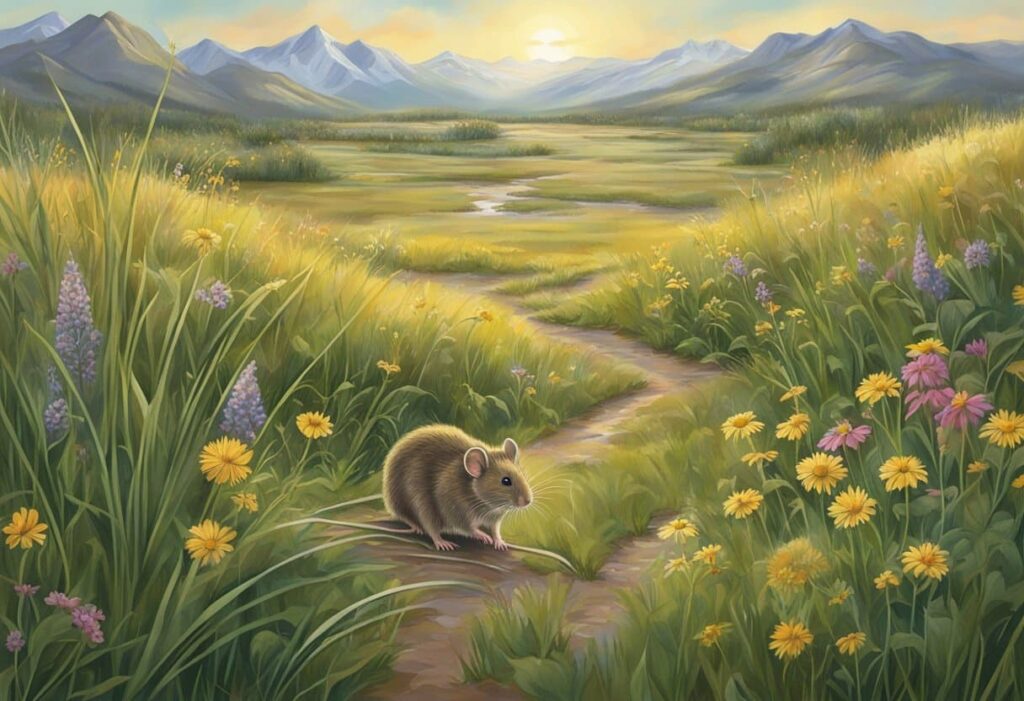
Mice and voles might look similar at first glance, but knowing the difference is crucial for effective control. Mice prefer to nest inside homes and have longer tails and larger ears, while voles primarily stay outdoors, creating visible runways through grass and snow.
These rodents can transform beautiful Colorado landscapes into damaged terrain within days. Voles chew through plant roots and tree bark, leaving distinct gnaw marks and tunnel systems. Mice, meanwhile, contaminate food sources and can spread diseases through their droppings.
Overview Of Voles And Mice
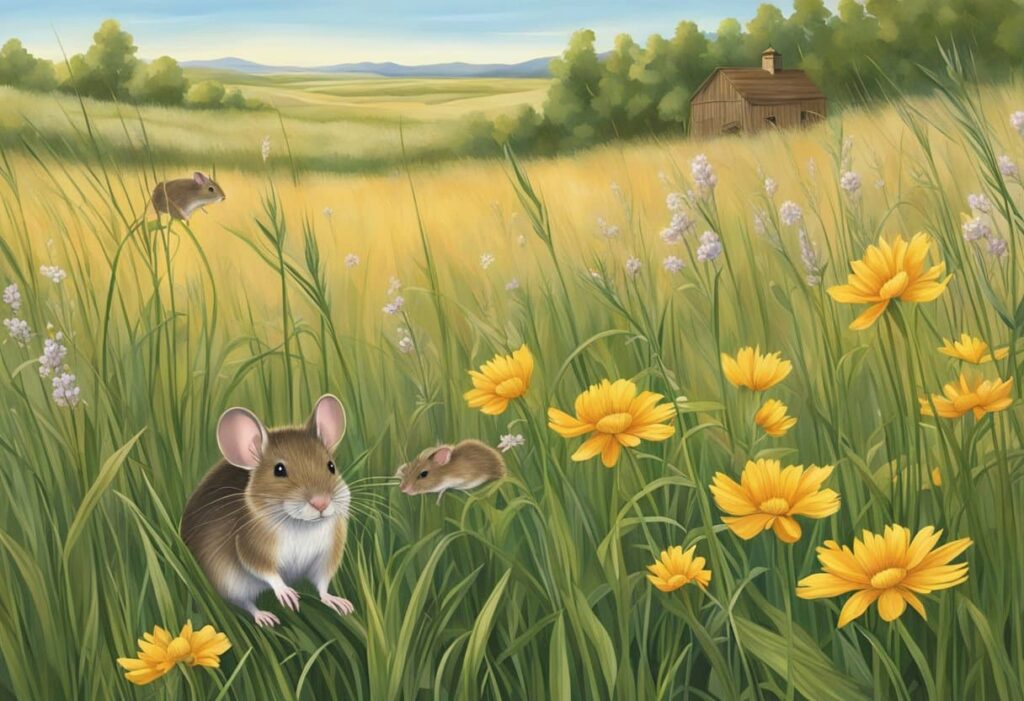
Voles and mice are small rodents commonly found throughout Colorado, but they have distinct differences in appearance, habitat, and behavior.
What Are Voles?
Voles are small, stocky rodents often mistaken for mice. They feature short tails, rounded snouts, and small ears partially hidden by fur. Colorado is home to several vole species, including the meadow vole and long-tailed vole.
Unlike mice, voles create surface runways in grass and snow. These paths measure about 1-2 inches wide and form complex networks across lawns and fields.
Voles are primarily herbivores, feeding on grasses, roots, bulbs, and tree bark. They can cause significant damage to gardens and orchards, especially during winter when they gnaw on tree bases under snow cover.
These rodents reproduce quickly, with females capable of having 5-10 litters yearly. A single meadow vole pair can potentially produce over 100 offspring in one year under ideal conditions.
What Are Mice?
Mice are small, slender rodents with pointed snouts, large ears, and long tails relative to their body size. In Colorado, common species include the house mouse and deer mice.
Unlike voles, mice are excellent climbers and jumpers. They can scale vertical surfaces and squeeze through openings as small as a dime. Their long tails provide balance for these acrobatics.
Mice are omnivores, eating seeds, grains, fruits, and insects. Deer mice mainly live outdoors in fields and forests, while house mice prefer living near humans in buildings.
These rodents build nests using shredded materials like paper, fabric, and insulation. Their droppings are pointed at the ends, unlike voles’ cylindrical droppings.
Mice can spread diseases through their urine, droppings, and saliva. Deer mice, in particular, can carry hantavirus, a serious respiratory disease that affects humans.
Visual Differences: How To Tell Them Apart
Identifying whether you’re dealing with a mouse or vole requires careful observation of their physical characteristics. These small rodents have distinct features that can help with proper identification.
Size And Body Shape
Mice typically measure 3-4 inches in body length, with an additional 3-4 inches of tail. They have a slender build with pointed snouts and larger, more prominent eyes.
Voles are stockier, measuring about 3-7 inches in total length depending on the species. Their bodies appear more robust with blunt, rounded snouts.
The overall silhouette differences are quite noticeable when viewed side by side. Mice appear more athletic and agile, while voles have a chunky, compact appearance.
A field biologist might describe mice as “streamlined” compared to the “potato-shaped” voles.
Fur And Coloration
Mice in Colorado typically display light brown to gray fur on their backs with lighter, often white or cream-colored bellies. Their fur appears smooth and somewhat glossy.
Voles feature darker brown to nearly black fur, with less contrast between back and belly coloration. Their fur looks thicker and has a coarser, shaggier texture.
Color Pattern Comparison:
- House Mouse: Light brown/gray with defined belly contrast
- Deer Mouse: Brown with stark white belly
- Meadow Vole: Dark brown all over
- Prairie Vole: Grayish-brown with minimal belly contrast
Seasonal changes may slightly affect coloration, but these general patterns remain consistent year-round.
Ears And Tails
Mice have prominent, large ears that stand out from their heads. Their tails are long (often equal to their body length), thin, and typically have sparse hair.
Voles possess much smaller ears that appear partially hidden in their fur. Their tails are noticeably shorter—usually less than half their body length—and covered with fine hair.
When observed from above, a mouse’s ears create a distinctive silhouette against its head while a vole’s ears barely protrude.
The tail difference serves as perhaps the most reliable identification feature in quick sightings. A long, thin tail almost certainly indicates a mouse, while a stubby tail points to a vole.
Behavioral And Habitat Differences
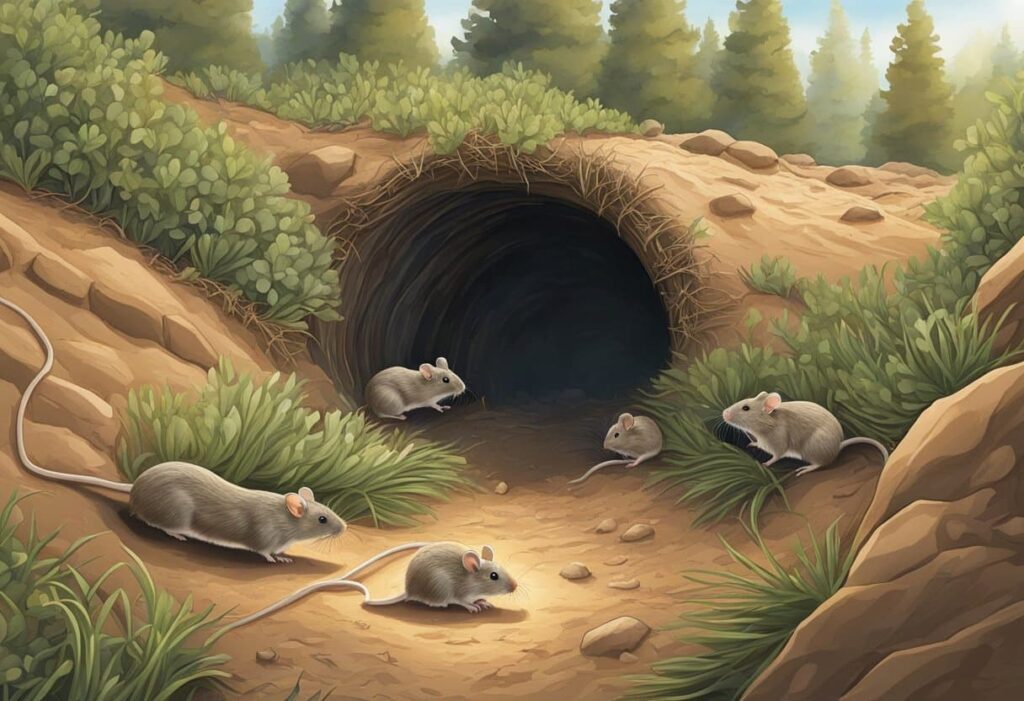
Mice and voles have distinct behaviors and prefer different environments, which affects how they interact with Colorado’s landscape and human properties.
Where They Live
Mice typically make homes in human structures, walls, basements, and attics. They’re adaptable creatures that thrive near human settlements where food is abundant.
Voles prefer outdoor habitats with thick ground cover. They create tunnel systems in grassy areas, especially in fields with buffalo grass, blue grama, and dwarf fescue. These tunnels protect them from predators like hawks, foxes, and coyotes.
Both rodents seek shelter during winter months. Mice move indoors while voles remain active beneath snow cover, continuing to feed on roots and bark.
Prairie dogs and pocket gophers compete with voles for underground space in open grasslands. In mountain regions, voles inhabit areas near conifer and evergreen forests, creating nests among fallen logs and dense vegetation.
Feeding Habits
Mice are omnivorous scavengers. They eat:
- Seeds and grains
- Fruits and vegetables
- Insects and their larvae
- Human food scraps
- Pet food left accessible
Voles maintain a primarily vegetarian diet. They consume:
- Grass stems and roots
- Tree bark (especially in winter)
- Bulbs and tubers
- Seeds when available
This difference in diet explains why mice invade homes seeking human food while voles damage lawns and gardens by eating plant material. During Colorado’s harsh winters, voles can cause significant damage to young trees by gnawing on bark beneath the snow line.
Mice store food in hidden caches while voles tend to eat continuously, consuming nearly their body weight daily.
Signs Of Presence
Mice leave distinct evidence including:
- Droppings (small, dark, and rice-shaped)
- Gnaw marks on food packages and wooden structures
- Nesting materials like shredded paper or fabric
- Scratching sounds in walls and ceilings
Vole evidence appears outdoors:
- Surface runways in grass (1-2 inches wide)
- Pushed-up soil from tunnel construction
- Irregular patches of damaged lawn
- Gnawed bark at the base of trees and shrubs
Trapping confirms which rodent you’re dealing with. Mouse traps work best indoors with peanut butter bait. Vole traps require strategic placement in runways.
Habitat modification helps prevent both pests. Reducing ground cover, maintaining distance between plantings and foundations, and securing food sources limits their presence.
Lawn Damage: What Causes It—Voles Or Mice?

Spotting lawn damage in your Colorado yard can be frustrating. The culprits are often small rodents that work quickly and quietly.
Vole Damage Signs:
- Visible surface runways (1-2 inches wide)
- Dead grass patches in irregular patterns
- Snow melt reveals winding trails across lawn
- Sudden appearance of multiple tunnels
Voles create extensive tunnel networks just beneath your grass. These industrious rodents don’t hibernate, meaning they cause damage year-round, even under snow cover.
Their tunneling behavior destroys grass roots and creates unsightly paths across lawns. A single vole family can damage hundreds of square feet in just one season.
Bark and Root Damage:
| Damage Type | Vole Characteristics |
|---|---|
| Bark | Irregular gnaw marks at base of trees |
| Roots | Underground feeding causing plant death |
| Plants | Complete disappearance of bulbs and tubers |
Mice, however, typically don’t create lawn runways. They prefer indoor spaces or areas with more cover like compost piles and garden sheds. Their damage focuses on stored items rather than your lawn.
The size of the damage area helps identify the pest. Vole damage spreads widely across yards, while mice typically create smaller, more concentrated problem areas.
Fresh vole damage appears as raised ridges in lawns. The tunnels collapse over time, leaving dead grass strips that can take months to recover without treatment.
Why Proper Identification Is Crucial For Treatment
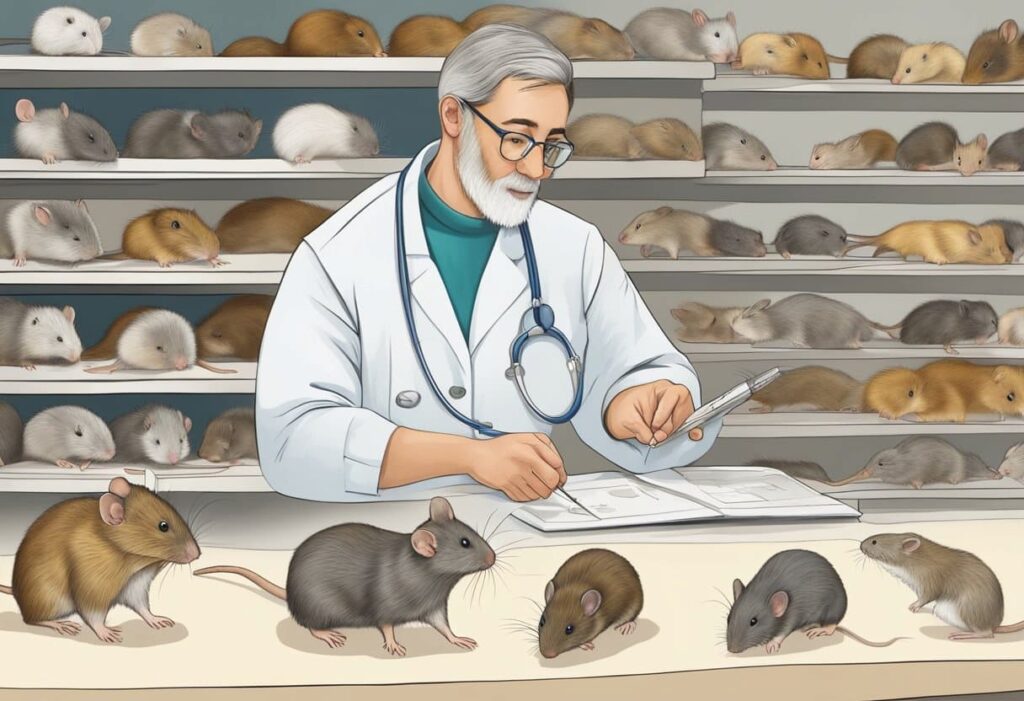
Telling the difference between mice and voles directly affects treatment success. Misidentification leads to wasted time, money, and continued property damage.
Mice primarily invade homes and buildings, requiring indoor exclusion methods like sealing entry points and strategic trap placement. Voles, however, remain outdoors and require completely different lawn and garden protection strategies.
Using mouse control techniques on voles won’t solve the problem. Similarly, vole control methods won’t stop mice from entering your home.
Treatment Differences:
- Mice: Require exclusion, indoor traps, and baiting stations
- Voles: Need lawn treatments, habitat modification, and perimeter protection
Physical characteristics help with proper identification. Mice have larger ears, longer tails, and pointed snouts. Voles feature smaller ears, shorter tails, and blunt faces.
The wrong approach not only fails to eliminate the pest but may create new problems. For example, certain baits effective for mice might not attract voles at all.
Seasonal behaviors also impact treatment timing. Mice seek indoor shelter year-round, while vole activity peaks during spring and fall when lawn damage becomes most visible.
Professional pest control experts can quickly identify the specific rodent and implement the correct treatment plan. This saves property owners from the frustration of ineffective DIY attempts.
How Solatera Pest Control Handles Voles And Mice
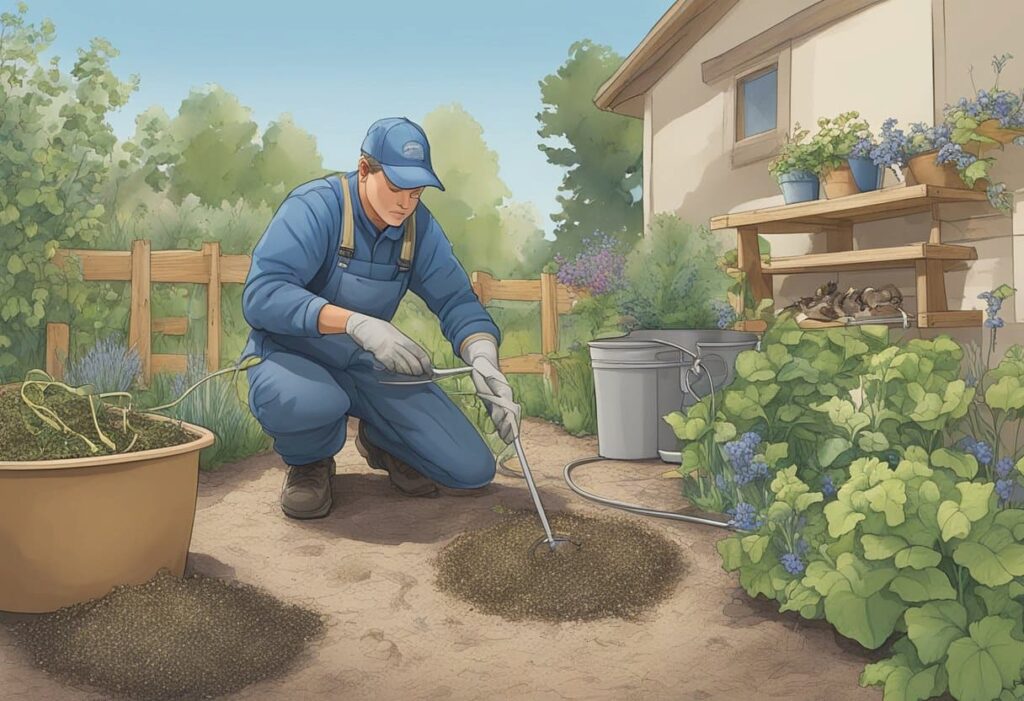
Solatera Pest Control tackles rodent problems with a systematic approach. Their team first conducts a thorough property inspection to identify entry points and nesting areas for both mice and voles.
For vole control, Solatera uses a combination of methods:
- Exclusion barriers around gardens and landscaping
- Habitat modification to reduce attractive living conditions
- Specialized baiting systems placed in strategic locations
- Repellents containing thiram or capsaicin for natural deterrence
Mouse infestations receive equally detailed attention. Solatera technicians deploy multiple control tactics:
- High-quality mouse snap traps in precise locations
- Rodenticides placed in tamper-resistant stations
- Exclusion work to seal entry points as small as a dime
- Regular monitoring to track elimination progress
The company practices Integrated Pest Management (IPM) principles. This approach minimizes chemical use while maximizing effectiveness against rodent infestations.
Solatera’s methods differ from DIY approaches by applying professional-grade products and techniques. Their technicians receive ongoing training in wildlife management and rodent control strategies.
For severe cases, Solatera may employ specialized fumigants or poison grain baits, always following strict safety protocols. They work year-round, as Colorado’s climate creates different rodent pressure depending on the season.
Clients receive custom prevention plans after treatment. These focus on long-term solutions rather than temporary fixes, ensuring homes remain free of both mice and voles.
Protect Your Lawn—Schedule A Rodent Assessment Today

Mice and voles can quickly turn a beautiful Colorado lawn into a damaged mess. These small rodents create tunnels, eat roots, and leave behind visible trails that harm grass health.
Early detection can save homeowners hundreds of dollars in lawn repairs. Most people don’t notice the problem until significant damage has occurred.
Signs of rodent activity include:
- Brown trails through grass
- Small mounds of soil
- Chewed plant bases
- Sudden plant death
Solatera Pest Control’s expert technicians can spot even subtle signs of infestation before they become major problems. Their trained eyes catch what homeowners often miss.
The inspection process is quick and non-invasive. Technicians examine the lawn, garden areas, and potential entry points around the home’s foundation.
Spring and summer are prime times for rodent activity in Colorado lawns. Acting now can prevent damage from spreading throughout the entire yard.
For a limited time, Solatera is offering free rodent assessments for new customers. The 30-minute inspection comes with no obligation and provides peace of mind.
Booking takes less than two minutes online or by phone. Flexible scheduling includes weekend appointments for busy homeowners.
Request a Free Vole & Rodent Inspection
Frequently Asked Questions
Colorado residents often encounter issues with mice and voles in their properties. Here are answers to common questions about these rodents and how to manage them effectively.
What are the effective methods to eliminate voles in Colorado landscapes?
Trapping offers a direct approach to vole control. Snap traps or live traps placed perpendicular to runways can capture these pests.
Natural predators like owls and hawks help control vole populations. Installing owl boxes in your yard encourages these beneficial hunters.
Habitat modification works well for long-term control. Remove dense ground cover and maintain a buffer zone around gardens with short grass or gravel.
Professional pest services provide comprehensive solutions when infestations become severe. They offer targeted treatments that consider Colorado’s specific ecosystem.
How can I differentiate between voles and mice in my Colorado property?
Voles have stockier bodies with shorter tails and smaller ears than mice. They typically measure 4-6 inches including their tail.
Mice appear more slender with larger ears and longer tails relative to their body size. House mice usually reach 5-8 inches including their tail.
Behavior patterns differ significantly. Voles create visible surface runways in grass, while mice tend to stay hidden and travel along walls indoors.
Droppings provide another clue – vole droppings are larger and appear in their outdoor runways, while mouse droppings are smaller and found near food sources.
What characteristics distinguish Colorado voles from other rodent species?
Colorado voles dig extensive tunnel systems with multiple entrance holes about 1-2 inches wide. These systems can span large areas of a yard.
Their teeth continue growing throughout their lives, requiring constant gnawing. This leads to distinctive chew marks on plants and trees.
Voles reproduce extraordinarily quickly. A female can produce 5-10 litters per year with 3-6 young per litter in Colorado’s climate.
Most Colorado voles remain active year-round, including winter months when they tunnel under snow. This “subnivean” activity often goes unnoticed until spring.
Are there common signs that indicate a vole infestation in Colorado?
Surface runways in lawns represent the most visible sign of voles. These 1-2 inch wide paths connect burrow entrances and feeding areas.
Gnawed tree bark near the soil line suggests vole activity. They often create a girdling effect that can kill young trees and shrubs.
Sudden plant death, especially of bulbs and perennials, indicates underground feeding on roots. Plants might appear to pull out easily from the soil.
Small entrance holes throughout the yard or garden, particularly in areas with dense vegetation, point to an active vole population.
Can mice populations in Colorado cause significant damage to homes or gardens?
House mice contaminate food with droppings and urine, potentially spreading diseases. A single mouse can produce 50-75 droppings daily.
Electrical wiring damage poses a serious concern. Mice constantly gnaw to wear down their teeth, often choosing home wiring which creates fire hazards.
Insulation becomes damaged as mice use it for nesting materials. This reduces a home’s energy efficiency and increases utility costs.
Garden damage from mice typically focuses on seeds and young seedlings rather than established plants. They will harvest and store seeds for winter food.
What are the best practices for preventing vole and mice infestations in Colorado?
Regular yard maintenance reduces habitat appeal. Keep grass short, remove weeds, and clear brush piles where rodents hide.
Hardware cloth barriers protect vulnerable plants. Install it 6-8 inches below soil level around garden beds and young trees.
Seal home entry points to prevent mice invasions. Check for gaps around pipes, vents, doors, and foundation cracks larger than ¼ inch.
Remove food sources by storing bird seed in metal containers, picking up fallen fruit, and keeping pet food indoors. Compost bins should be rodent-proof.
Seasonal inspections help catch problems early. Check your property in spring and fall when rodent activity often increases in Colorado.
